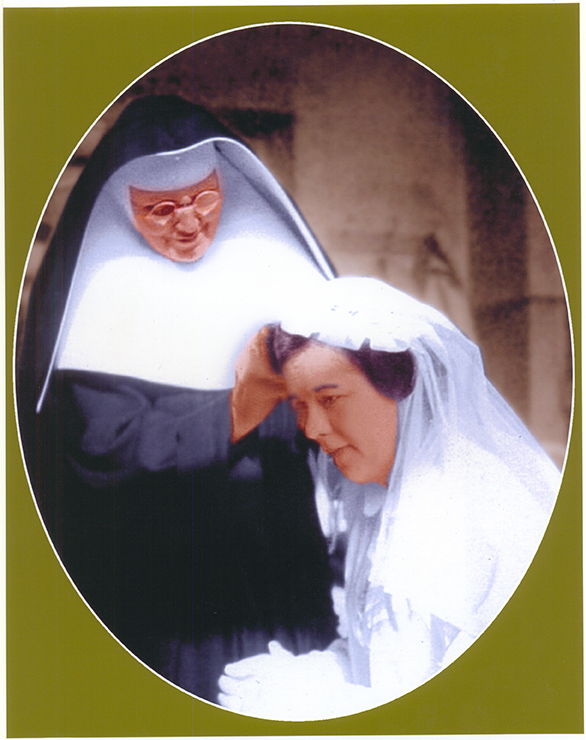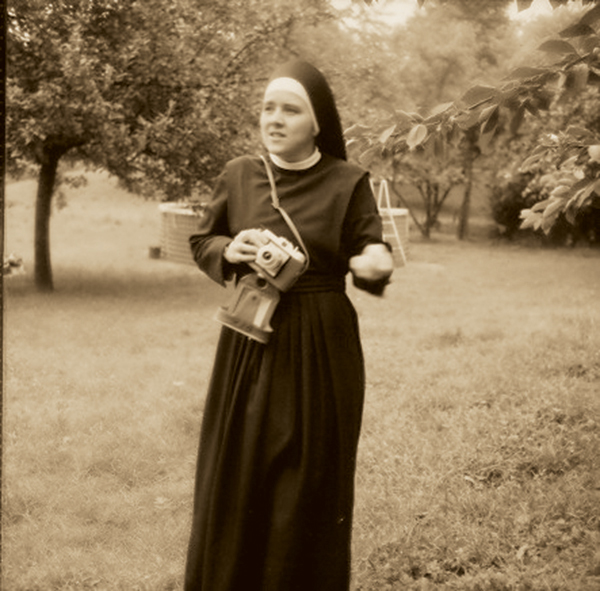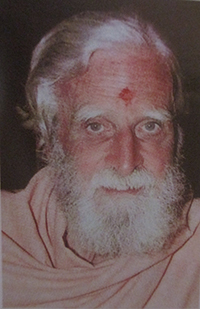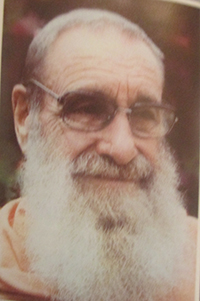Mother Petra was born on 14th June 1924, at Oelde in the Diocese of Munster in Germany, as the third child of her parents Bernard-Paula in Moennigmann family.
Both Bernard and Paula were pious Catholics and brought up their children in the strict tradition of Catholic Church. Paula was baptized on 18th June, 1924 at St. John Church Oelde.
 Family of Mother Petra
Family of Mother Petra
When Paula was two years of age, she joined the kinder garden. At the close of the three years of kinder garden, Paula was admitted to the primary school.
At the threshold of her youth hood, Paula proved to be bright and brilliant and an extra ordinary gifted student. She was blessed with joyful spirit, firmness of decision, unshakable self-confidence and a challenging attitude. In her youth she also went through the painful experience of the Second World War. Young Paula herself was an eyewitness of the horrible scene of cold-blooded murders. The terrified Paula developed a horror for bloodshed, injustice and cruelty. Paula was well aware of the adverse impact of war especially on the developing countries like India reflected in the media. Her heart was moved with compassion towards the poor and suffering.
The Nazi rule in Germany persecuted the Jews, and believers of all mankind, weakening religious and faith. As a courageous girl, Paula played a prominent role in a secret association of students working against the movement of Narzism.
At the later stage, Mother Petra herself stated, “The beginning of my vocation goes back to the time of Church persecution in Germany before and during the second world war”.
After her college studies, Paula joined the religious order of Ursulines in Germany founded by St. Angela Merici and became an Ursuline nun in 1954, she made her final vows on 29th September 1957 and took the name ‘ Sr. Petra of the Holy Cross ’. During this time, Germany became one of the richest nations of the world.
 Profession at Ursuline Congregation
Profession at Ursuline Congregation

Mother Petra was a renowned educator, a good formator and a skilled musician. As a professional teacher, Mother Petra taught in the school of Neheim until 1966. Mother Petra was very lively and dynamic woman and won the hearts of the students. She was pious and had great trust in the providence of God. Mother Petra was a charming person among the staff. She put motivation and fire in the youthful minds to respond to the needs of the suffering humanity. During her life at Werl, she was often laid up with serious illness and had undergone acute suffering. The cross of affliction never left her and she literally lived her name ‘ Sr. Maria Petra of the Holy cross ’ till the end. Yet in all her ailments, she never complained, never lost courage.
Inspite of all her prestigious positions, name and fame, Mother Petra was unhappy and was not satisfied with her life and assignments as a teacher. Her interest grew in the suffering people, the sick, the lepers, the hungry and the abandoned. She longed to become a missionary, working for the poor in the developing countries. The media news about the misery of people in India created a strong vibration of sympathy in her heart. She tried to respond to this people by sending medical aids and material help. But her conscience was never left her at peace. She felt that God did not want her gift to the poor, but to give herself to them. She heard the inner voice “You must go”, which later turned into a compulsion within, to give up her comforts to serve the poor.
Mother Petra began to pester her Superiors with the request to be sent abroad as a missionary. Her superior sent her to Freiburg to the Tropical Institute to find out how fit she would be to live in a tropical country. Here at this centre, Mother Petra met Dr. Rhode, a German physician working in Caritas hospital at Kottayam in India. Dr. Rhode spoke of a standing invitation of the Bishop of the Diocese of Kottayam for a sister to work at the Caritas Secular Institute in India, for three years as destined by God, Mother Petra decided to accept the invitation.
Mother Petra arrived at Mumbai in India, her dream land, on June 26th, in 1966. From there she proceeded to Kochi and she was received by Caritas authority.
Mother Petra took her new assignment at Caritas on 4th July 1966. She was given the responsibility of training the novices at Caritas Secular Institute. She also engaged herself in hospital services.
During her stay at Caritas, she got ample opportunities to visit the nearby villages where she came across the grim realities of poverty, sickness and exploitation which made her deeply distressed and restless. Mother Petra could not find peace and contentment in her life and service at Caritas. She realized her calling to be something different; something infinitely higher.
Mother Petra had vacation trip with her colleagues to Moonar. On their way, their vehicle failed at a village. Mother Petra made a causal visit to the village. She was shocked to see the real poverty and utter misery of people. The face of emaciated women with pitiable thin and emaciated, carrying children and babies covered with pus running sores, disfigured by inflated bellies, living in huts worse than a cattle-barn, imprinted in her. Her heart melted with pity and asked herself, “What could I do for these people”? The picture of poverty and penury of the people never passed from her mind, “How to serve such poor and abandoned”? She began to be disturbed.
Though Mother Petra continued her picnic with her team, she could not enjoy the comforts offered to her. Her conscience heavily pricked. She began to ask herself: “Have I come all the way from Germany to India, to enjoy the privileges of the upper class? To belong to the rich?” she reflected over the Gospel passage narrating the story of ‘ the rich man sitting at the well set tables, and the poor Lazarus at the door steps hoping for the mercy of dogs ’. She felt that she was not doing enough for the poor.
Coming down from Moonar, Mother Petra was obsessed with the thought that she should spend all her energies for the poor alone. This experience is described as the surrounding reasons for the development of the charism that the Holy Spirit gifted to her.
Mother Petra then went to Kurisumala, a hill top in the district of Kottayam where the Cistercian monks have an ashram. In the solitude and silence of the Ashram, she spent hours in intimacy with the Lord, reflecting, meditating and planning about her future. Here at this mountain of the Lord, Mother Petra saw the light and experienced the warmth of divine love. She clearly visualized her ‘ Call within the Call ’...for something great....
Kurusumala remained a kind of a spiritual home land and heaven of refuge for her. She was profoundly influenced and inspired by the ascetic life of Fr. Francis Achariya and his successor Fr. Bede Griffths. She opened her heart and revealed herself to Fr. Bede. As he could discern the guiding spirit in her, he told “Sr. Petra, I must tell you, an extra ordinary divine providence is guiding you”. It was here, that Mother Petra discerned her true vocation certainly by Divine as well as human intervention.
 Fr. Bede Griffiths O.C.S.O
Fr. Bede Griffiths O.C.S.O
 Fr. Francis Achariya O.C.S.O
Fr. Francis Achariya O.C.S.O
As it was the expiry of the period of contract with the Bishop of the Diocese of Kottayam, as well as of her exclaustration, she tried to get an extended her permission which was not granted. Mother Petra then wished to begin a branch of the Ursuline Congregation in India, but her proposal did not find favour with her superior. At this stage, she had left only two options, either to leave the Congregation or to give up her cherished desire to live for the poor in India. It was indeed a heart breaking decision for her, to leave her community in Germany; however, her passion for the poor surpassed everything else. She made herself a holocaust and a self-oblation for the poor.
At the completion of the legal process of leaving the order of Ursulines, mother Petra renewed her religious vows of Chastity, Poverty and Obedience, adding a promise of the Service of the Poor, on 18th of April 1969 before Bishop Patroni. Thereafter, Mother Petra added the term Dinadasi to her name.
1st of June 1969 witnessed the long awaited dawn of the birth of Dinasevanasabha (Servants of the Poor). Eight young girls from different parts of Kerala joined Mother Petra for her new venture. With the paternal blessings and canonical approval of Rt. Rev. Dr. Aldo Maria Patroni, Mother Petra officially founded the community of Dinasevanasabha at Pattuvam in the Diocese of Calicut as a pious association with the motto of “Service in Charity and Poverty”.
The spiritual communion of Mother Petra with the Lord in the Holy Eucharist and her contemplation of the face of Jesus on the cross enabled her to see the disfigured face of Christ in the poor whom she served. Her trust in the providence of God was remarkable and unshakable. Her encounter with Jesus in the Blessed Sacrament instilled in her an ardent desire to sacrifice her life for the poor.
For Mother Petra, works of charity are not merely helps to the poor, but to transformation to be creative and to be pro-active to go to the root of poverty and misery and to find out means to remove its causes.
God granted Mother Petra only a short span of seven years to give shape to the Congregation. Inspite of her persistent ailment, she worked hard with incredible energy and will power. She started 20 convents, formed candidates in her Charism, charged with the spirit of the Second Vatican Council and the rich religious traditions of India. She died along four of her sisters in a tragic road accident on 5th June, 1976 at Manantheri, on their way back to Pattuvam from Mananthavady.
Mother Petra wished to be part of the India during life and after death. She made it clear to Sr. Willigard at Germany, “If I die here, please do send my mortal remains to Kerala for that land I have offered my life as a holocaust in service”. As her wish, her mortal remains were buried in the crypt attached to the DSS Ashram chapel at Pattuvam.
Rev. Dr. Varghese Chakkalakal the Bishop of Kannur declared Mother Petra Dinadasi as Servant of God on 14th June 2009, considering her holiness and manifold favors received through her intercession for many people. On 29th June 2010, the Beatification and Canonization Process of the Servant of God Mother Petra Dinadasi was officially started by forming the diocesan Tribunal Commission, Theological and Historical Commissions and the work is now continuing. In 2012 October 28th her Mortal Remains Exhumed, Identified, Replaced in the new tomb prepared in the Ashram Chapel.